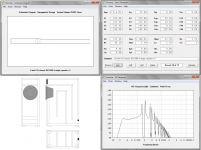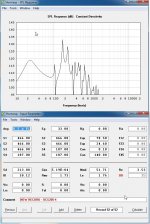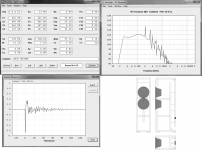Does HornResp have an option to determine the air velocity in the system (specifically at the exit port) to make use my design isn't calling for supersonic airflow (which would be cool from one perspective, but I guess terrible from a sound perspective)?
Do you think these (FMOD Crossover Pair 20 Hz High Pass 266-246) might work as "rumble filters"?2. Even if your Marantz has a reasonable bass management feature it is still lacking features that even most of the cheapest Sub Amps have
- missing a subsonic(rumble) filter - usually at around 15>18Hz - if you don't have one your NAD amps may consume most of their power just trying to amplify LF rumble...
I've gone back to the version with 2-8" woofers. I think I have a design I will use. the only problem is the response has a slope so that it drops ~4 dB over the range I'd want to use it. The good news is HornResp says it should get down to near 20 Hz. I have included the 3 view and the HornResp output.
Attachments
For some reason I can not get hornresp to cooperate. Am I missing some thing?? 🙂
ID=29.00
Ang=0.5 x Pi
Eg=33.00
Rg=0.00
Fta=0.00
S1=466.00
S2=466.00
Exp=78.50
F12=0.00
S2=466.00
S3=466.00
Exp=24.60
F23=0.00
S3=466.00
S4=187.00
Con=0.10
F34=0.00
S4=187.00
S5=187.00
Con=140.00
F45=0.00
Sd=213.80
Bl=10.12
Cms=5.19E-04
Rms=1.73
Mmd=51.71
Le=1.76
Re=3.53
OD=2S
Vrc=0.00
Lrc=0.00
Fr=0.00
Tal=0.00
Vtc=0.00
Atc=0.00
Pmax=100
Xmax=5.0
Comment=NEW RECORD - DCS205-4
ID=29.00
Ang=0.5 x Pi
Eg=33.00
Rg=0.00
Fta=0.00
S1=466.00
S2=466.00
Exp=78.50
F12=0.00
S2=466.00
S3=466.00
Exp=24.60
F23=0.00
S3=466.00
S4=187.00
Con=0.10
F34=0.00
S4=187.00
S5=187.00
Con=140.00
F45=0.00
Sd=213.80
Bl=10.12
Cms=5.19E-04
Rms=1.73
Mmd=51.71
Le=1.76
Re=3.53
OD=2S
Vrc=0.00
Lrc=0.00
Fr=0.00
Tal=0.00
Vtc=0.00
Atc=0.00
Pmax=100
Xmax=5.0
Comment=NEW RECORD - DCS205-4
Do you think these (FMOD Crossover Pair 20 Hz High Pass 266-246) might work as "rumble filters"?
Yes, they will work somewhat but since they are passive they are very shallow (3db/octave) they won't have a great effect at sharply cutting of LF below 20hz.
IMHO, I would wait until you finished your sub and see if they are needed before you spend the money on these,
Do you think these (FMOD Crossover Pair 20 Hz High Pass 266-246) might work as "rumble filters"?
Awfully pricey for what is essentially a non-optimumal PLLXO.
dave
that was more or less my plan. Both the Marantz and NAD I think have rumble filters built in.IMHO, I would wait until you finished your sub and see if they are needed before you spend the money on these,
It looks a lot better when you sum the port's output to the driver's, so go into 'tools' and click on 'combined response'. Note too that HR's corner loading [0.5pi] is a bit too optimistic compared to many rooms, so use 1pi for a more realistic response.
GM
GM
Note, I am using 2 pi because it is not going into a corner.It looks a lot better when you sum the port's output to the driver's, so go into 'tools' and click on 'combined response'. Note too that HR's corner loading [0.5pi] is a bit too optimistic compared to many rooms, so use 1pi for a more realistic response.
Here are two versions of the speaker. One is my prior version, and the other is a shorter version with a shorter port the ends up exiting out the rear of the box. The larger one has a "deeper" response, but has quite a bit of slope to the response. The smaller one doesn't go as low, but it has a flatter response curve. I can build either using one sheet of MDF or the wood veneer plywood and both are within my skill level in wood working (amateur). So is it better to go lower and have the sloping response, or not go as deep and have a flatter response?
Attachments
The version that goes deeper also goes louder. The sloping response can easily be handled with a bit of equalization. I'd go for it.Here are two versions of the speaker. One is my prior version, and the other is a shorter version with a shorter port the ends up exiting out the rear of the box. The larger one has a "deeper" response, but has quite a bit of slope to the response. The smaller one doesn't go as low, but it has a flatter response curve. I can build either using one sheet of MDF or the wood veneer plywood and both are within my skill level in wood working (amateur). So is it better to go lower and have the sloping response, or not go as deep and have a flatter response?
Joe L.
I was trying to figure out why that one went so much louder than the other. Then I figured it out. That's the 2S/2P difference. The actual volume difference between the two is MUCH less if I pick either 2P or 2S for BOTH.The version that goes deeper also goes louder.
In the words of the Great Rick Perry... "oops..."
Last edited:
One problem with having choices is there are lots of options. I just made a "new" design using the TB W8-740P speaker, and it seems to work better than the DA DCS205-4 version. The response is flatter, and even with the small box, the unit should theoretically get down to 25 Hz (6 dB). Oh, and the cost is about what I was looking at for the original 3-6.5" version.
So what do folks think of the W8-740P vs. the DCS205-4?
So what do folks think of the W8-740P vs. the DCS205-4?
Attachments
Last edited:
IIRC, this is the driver DSL uses in its TH-SPUD, so a solid performer. At a glance, it looks like a ~5.4 ft^3/20 Hz MLTL might do well. Yours has such a long vent that I'm thinking that too much vent output will be lost in damping its harmonics.
If you can, model it in AkAbak or MJK's MathCad software to see.
GM
If you can, model it in AkAbak or MJK's MathCad software to see.
GM
- Status
- Not open for further replies.
- Home
- Loudspeakers
- Subwoofers
- Small Tower Subwoofer Project




